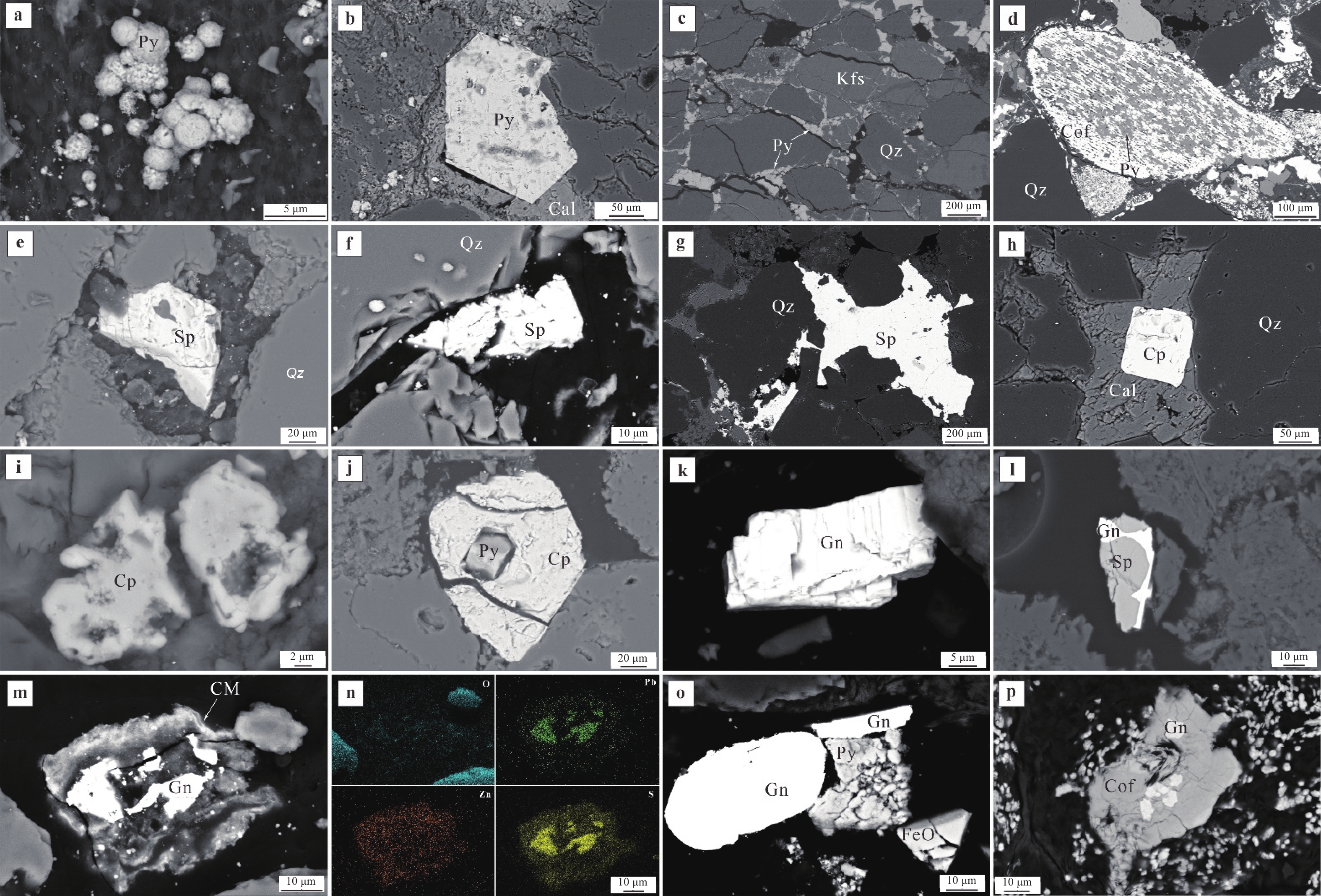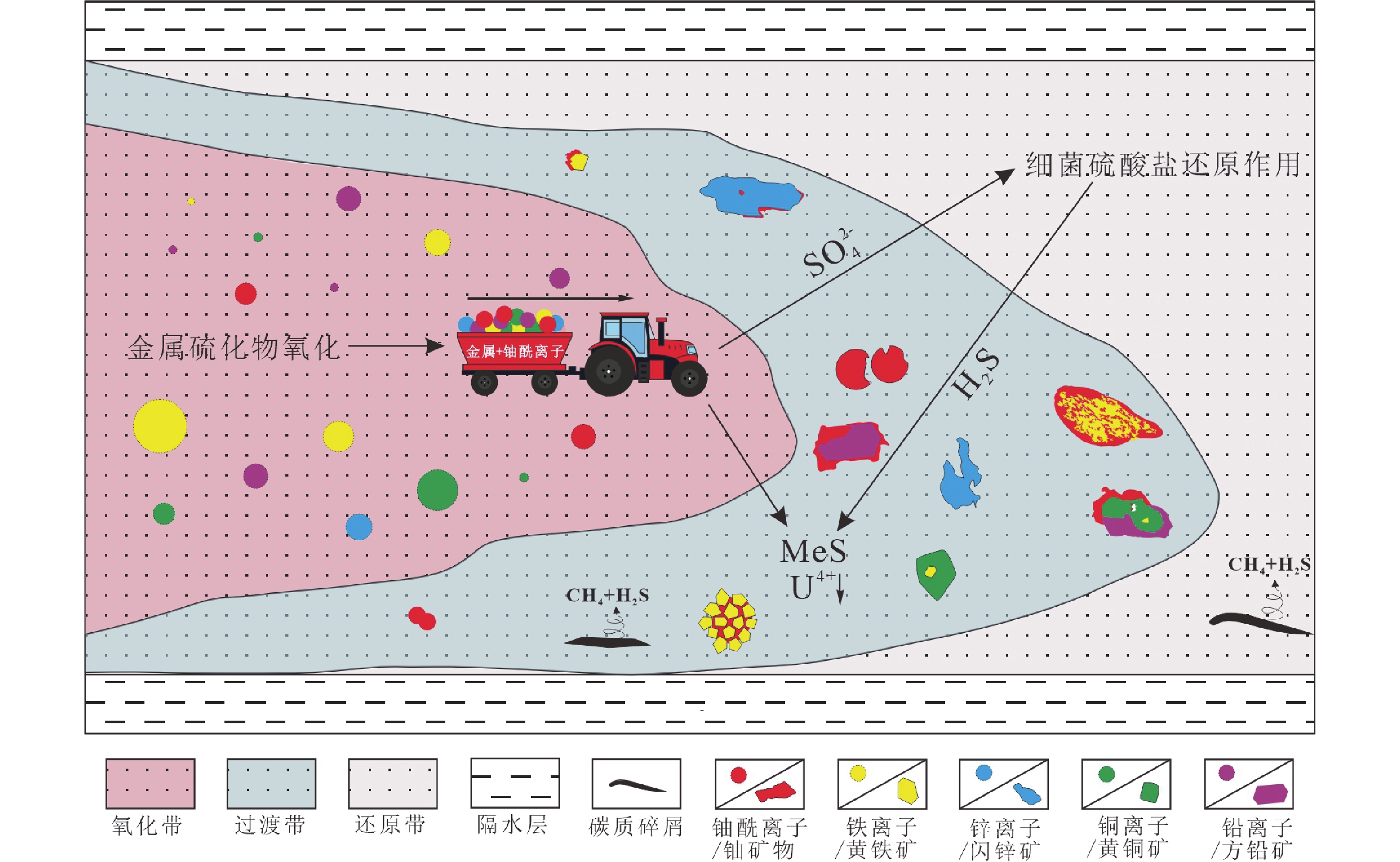The Occurrence State of Metal Sulfides and Its Relationship with Uranium Mineralization in Diantou-Shuanglong Area, Ordos Basin
-
摘要:
在砂岩型铀矿勘查中,除了黄铁矿以外还识别出其他种类丰富的金属硫化物,但目前对于其复杂的矿物种类、微观形态、赋存特征以及和铀矿物关系缺少系统性研究。本文以店头-双龙地区中侏罗世直罗组赋矿岩层为研究对象,利用光学显微镜、扫描电镜以及配备的能谱仪和全反射X射线荧光光谱等方法识别出大量金属硫化物,以黄铁矿、闪锌矿、黄铜矿和方铅矿为主;并在含矿砂岩的过渡带发现金属硫化物呈现出残留的氧化痕迹并被铀矿物所取代。通过对古层间氧化带不同分带中金属硫化物的含量进行统计,由高到低依次为过渡带的含矿砂岩>还原带的灰色不含矿砂岩>二次还原的绿色砂岩≥氧化的红色砂岩;不同类型硫化物含量由高到底依次为黄铁矿>闪锌矿>黄铜矿≥方铅矿。氧化带酸性或偏酸性的地下水以及存在的Fe3+为金属硫化物的氧化提供有利条件。铀酰离子伴随着金属硫化物氧化形成的离子络合物随氧化流体在铀储层砂体中运移,随着还原介质占主导地位,金属离子在过渡带重新富集沉淀形成成矿期金属硫化物。与此同时,过渡带的金属硫化物氧化形成的$ {\text{SO}}_{\text{4}}^{{2-}} $可被还原为H2S,而H2S对铀酰离子具有很强的还原能力。因此,金属硫化物和铀矿物紧密伴生,说明除了黄铁矿以外,其他类型的金属硫化物也可充当还原剂来参与铀的富集沉淀,这对其他砂岩型铀矿床无机还原介质的研究提供一定的借鉴。
Abstract:In the exploration of sandstone-hosted uranium deposits, besides pyrite, other types of metal sulfides have been identified. Nevertheless, there is currently a lack of systematic investigation and research into the metal sulfides about their complex mineral types, microstructure, occurrence characteristics, and relationship with uranium minerals. Therefore, this paper takes the ore-bearing rock strata of the Middle Jurassic Zhiluo Formation in the Diantou-Shuanglong area as the research object. By utilizing optical microscopes, scanning electron microscopes, energy spectrometer, and synchrotron X-ray fluorescence, a large number of metal sulfides were identified, mainly including pyrite, sphalerite, chalcopyrite, and galena. Furthermore, in the transition zone of ore-bearing sandstone, the four principal metal sulfides manifest residual oxidation traces and are replaced by uranium minerals. Through the statistical analysis of the content of metal sulfides, the distribution of various metal sulfides in different zones of the ancient interlayer oxidation zone is as follows, ranked from highest to lowest content: ore-bearing sandstone in the transition zone>gray ore-free sandstone in the reduction zone>green sandstone in the secondary reduction zone≥oxidized red sandstone. The order of different types of metal sulfides content from high to low is pyrite>sphalerite>chalcopyrite ≥ galena. Comprehensive analysis indicates that the acidic or weakly acidic groundwater and the presence of Fe3+ in the oxidation zone can provide favorable conditions for the oxidation of metal sulfides. Uranyl ions accompanied by ion complexes formed by oxidation of metal sulfides migrate in the uranium reservoir with the oxidizing fluid. As reducing media dominates, the migrated metal ions are re-enriched and precipitated in the transition zone to form mineralization stage metal sulfides. Meanwhile, $ {\text{SO}}_{\text{4}}^{{2-}} $ formed by oxidation of metal sulfides in the transition zone can be reduced to H2S, which has a strong reducing ability for uranyl ions. Therefore, metal sulfides are closely associated with uranium minerals, indicating that beyond the well-known pyrite, other metal sulfides can also serve as reducing agents, actively participating in the enrichment and precipitation of uranium. This discovery offers valuable insights for the study of inorganic reducing media in other sandstone-hosted uranium deposits.
-
Key words:
- metal sulfides /
- uranium mineralization /
- Zhiluo Formation /
- metallogenic model /
- Diantou-Shuanglong area /
- Ordos Basin
-

-
表 1 研究区金属硫化物在探针片中所占比例
Table 1. The proportion of metal sulfides in the thin sections of the study area
岩性 样品号 金属硫化物占比(%) 总占比(%) 闪锌矿 黄铁矿 黄铜矿 方铅矿 红色+黄色砂岩(n=6) ZK319-05-8 / 0.034 0.0024 0.0061 0.0425 ZK2402-6 / / 0.049 / 0.049 ZK127-09-2 / 0.063 / / 0.063 ZK319-05-5 / / / / / ZK257-01-1 / / / / / ZK175-03-5 0.60 0.20 0.02 0.014 0.834 总占比(%) 0.60 0.297 0.0714 0.02 0.99 平均值(%) 0.1 0.05 0.012 0.003 0.17 绿色砂岩(n=5) ZK127-07-2 / 0.001 / / 0.001 ZK31-08-2 / 0.058 / / 0.058 ZK127-07-5 / 0.232 / / 0.232 ZK127-07-1 / 0.336 0.172 0.002 0.51 ZK31-08-5 / 0.12 / / 0.12 总占比(%) / 0.747 0.172 0.002 0.92 平均值(%) / 0.15 0.034 0.0004 0.18 灰色不含矿砂岩(n=8) ZK159-09-1 0.31 3.73 0.02 / 4.06 ZK323-01-3 0.23 3.4 0.01 0.013 3.65 ZK323-01-1 0.24 0.9 / 0.026 1.17 ZK159-14-2 / 2.11 / / 2.11 ZK003-32 / 2.03 / / 2.03 ZK143-02-3 0.22 1.23 / / 1.45 ZK143-02-6 0.1 1.98 0.02 / 1.982 ZK159-09-2 0.32 1.36 / / 1.68 总占比(%) 1.42 16.74 0.05 0.039 18.13 平均值(%) 0.18 2.09 0.006 0.005 2.28 含矿砂岩(n=8) ZK159-09-4 2.95 0.54 0.003 0.036 3.53 ZK159-09-5 0.05 5.22 无 0.163 5.43 ZK159-09-7 3.82 7.91 0.04 0.005 11.78 ZK159-09-8 2.79 4.18 0.009 0.008 6.99 ZKZ159-09-9 3.83 2.85 无 0.036 6.72 ZK175-03-1 5.2 3.0 0.02 0.09 8.31 ZK175-03-2 2.58 1.56 0.03 0.004 4.17 ZK175-03-6 2.35 2.95 0.003 0.029 5.33 总占比(%) 23.57 28.21 0.105 0.371 52.26 平均值(%) 2.95 3.53 0.01 0.05 6.54 注:/代表百分比小于0.001,可忽略不计. -
[1] 曹惠锋,刘厚宁,杜 鹏,彭小华.2018.鄂尔多斯盆地南缘双龙铀矿床地质特征及铀矿物类型探析[J]. 地质科技情报,37(5):148-153.
[2] 陈宏斌,徐高中,王金平,李卫红,赵夕刚.2006.鄂尔多斯盆地南缘店头铀矿床矿化特征及其与东胜铀矿床对比[J]. 地质学报,80(5):724-732. doi: 10.3321/j.issn:0001-5717.2006.05.013
[3] 陈祖伊,郭庆银.2010.砂岩型铀矿床层间氧化带前锋区稀有元素富集机制[J]. 铀矿地质,26(1):1-8. doi: 10.3969/j.issn.1000-0658.2010.01.001
[4] 程银行,金若时,Michel CUNEY, V. A. PETROV,苗培森.2024a.中国北方盆地大规模铀成矿作用:地层篇[J]. 地质学报,98(7):1953-1976
[5] 程银行,金若时,苗培森,王少轶,滕雪明.2024b.砂岩型铀矿的两种成矿模式:泾川式和塔勒式[J/OL].地球科学,1-13[2024-12-10].http://kns.cnki.net/kcms/detail/42.1874.P.20240827.1015.002.html.
[6] 焦养泉,吴立群,彭云彪,荣 辉,季东民,苗爱生,里宏亮.2015.中国北方古亚洲构造域中沉积型铀矿形成发育的沉积—构造背景综合分析[J]. 地学前缘,22:189-205.
[7] 焦养泉,吴立群,荣 辉,张 帆,陶振鹏,乐 亮. 2021. 铀储层非均质性地质建模—揭示鄂尔多斯盆地直罗组铀成矿机理和提高采收率的沉积学基础[M]. 武汉:中国地质大学出版社.
[8] 焦养泉,吴立群,荣 辉.2018.砂岩型铀矿的双重还原介质模型及其联合控矿机理:兼论大营和钱家店铀矿床[J]. 地球科学,43(2):459-474.
[9] 焦养泉,吴立群,杨生科. 2006. 铀储层沉积学—砂岩型铀矿勘查与开发的基础[M]. 北京:地质出版社.
[10] 金若时,滕雪明.2022.中国北方砂岩型铀矿大规模成矿作用[J]. 华北地质,45(1):42-57.
[11] 乐 亮. 2021. 鄂尔多斯盆地北部直罗组铀储层中黄铁矿的形成过程与演化规律[D]. 中国地质大学(武汉)博士学位论文.
[12] 李红阳,牛树银.2001.常见硫化物的氧化作用及其环境效应[J]. 北京地质,13(2):6-11.
[13] 李 强. 2017. 鄂尔多斯盆地南缘双龙铀矿床地表氧化改造的关键标志[D]. 中国地质大学(武汉)硕士学位论文.
[14] 李盛富,张 蕴.2004.砂岩型铀矿床中铀矿物的形成机理[J]. 铀矿地质,20(2):80-84+90. doi: 10.3969/j.issn.1000-0658.2004.02.003
[15] 李子颖,方锡珩,陈安平,欧光习,孙 晔.2010.鄂尔多斯盆地东胜砂岩型铀矿叠合成矿模式[J]. 矿床地质,29(S1):145-146.
[16] 刘池洋,赵红格,桂小军,岳乐平,赵俊峰,王建强.2006.鄂尔多斯盆地演化-改造的时空坐标及其成藏(矿)响应[J]. 地质学报,80(5):617-638. doi: 10.3321/j.issn:0001-5717.2006.05.001
[17] 刘金辉,孙占学.2004.确定砂岩型铀矿体定位新方法—水岩体系Eh-pH法[J]. 吉林大学学报(地球科学版),34(1):44-48.
[18] 刘 阳,曹惠锋,计 波,尹永朋,吴 力.2015.鄂尔多斯盆地南部双龙地区铀储层空间分布与成因[J]. 中国西部科技,14(5):32-34. doi: 10.3969/j.issn.1671-6396.2015.05.012
[19] 刘章月,邓华波,董文明,蔡根庆,刘红旭.2011.新疆巴什布拉克铀矿床成矿地球化学环境分析[J]. 世界核地质科学,28(3):125-131. doi: 10.3969/j.issn.1672-0636.2011.03.001
[20] 刘正义,许强,刘红旭,董文明,秦明宽,刘佳林,朱泉龙.2021.巴什布拉克含铀地沥青铀矿床矿化特征和成矿机理[J]. 西北地质,54(1):109-124.
[21] 彭小华,曹惠锋,刘厚宁.2018.鄂尔多斯盆地南部双龙地区铀成矿特征分析[J]. 世界核地质科学,35(1):8-15. doi: 10.3969/j.issn.1672-0636.2018.01.002
[22] 秦明宽,李子颖,蔡煜琦,郭 强,宋继叶,刘章月,黄少华.2022.对加强我国铀资源勘查“三新”突破的战略性思考[J]. 世界核地质科学,39:383-398. doi: 10.3969/j.issn.1672-0636.2022.03.001
[23] 孙 圭,赵致和. 1998. 中国北西部铀矿地质(下卷)[R]. 西安:核工业西北地质局.
[24] 汪小妹,焦养泉,吴立群,荣 辉,王小明,潘松圻,唐 辉,计 波,宋 霁.2011.鄂尔多斯盆地东胜—神木地区侏罗系煤中常量元素地球化学特征[J]. 沉积学报,29(3):520-528.
[25] 王大钊,冷成彪,秦朝建,段丰浩,周万蓬,许德如.2022.铀的地球化学性质与成矿作用[J]. 大地构造与成矿学,46(2):282-302.
[26] 王剑锋. 1998. 铀地球化学教程[M]. 北京:原子能出版社.
[27] 魏佳林,汤 超,徐增连,陈路路,肖 鹏,刘华健,曾 辉. 2019. 松辽盆地北部四方台组多金属硫化物与铀成矿关系浅析[C]. //中国矿物岩石地球化学学会第17届学术年会论文摘要集.
[28] 吴柏林,刘池洋,王建强.2007.层间氧化带砂岩型铀矿流体地质作用的基本特点[J]. 中国科学(D辑:地球科学),37(S1):157-165.
[29] 谢惠丽. 2016. 鄂尔多斯盆地大营铀矿床古层间氧化带形成发育的水-岩作用过程[D]. 中国地质大学(武汉)博士学位论文.
[30] 邢秀娟,柳益群,樊爱萍.2006.鄂尔多斯盆地店头地区砂岩型铀矿成因初步探讨[J]. 中国地质,33(3):591-597. doi: 10.3969/j.issn.1000-3657.2006.03.016
[31] 邢秀娟,柳益群,李卫宏,龚斌利.2008.鄂尔多斯盆地南部店头地区直罗组砂岩成岩演化与铀成矿[J]. 地球学报,29(2):179-188. doi: 10.3321/j.issn:1006-3021.2008.02.008
[32] 徐 阳. 2019. 鄂尔多斯盆地双龙地区砂岩型铀矿迁移、富集及成矿机制[D]. 中国科学院广州地球化学研究所硕士学位论文.
[33] 徐争启. 2019. 桂东南十万大山盆地地质特征与铀成矿作用[M]. 北京:科学出版社.
[34] 徐志良. 2017. 铀(VI)在合成黄铁矿和羟基磷灰石的作用机理研究[D]. 东华理工大学硕士学位论文.
[35] 晏泽夫. 2016. 鄂尔多斯盆地南缘双龙铀矿铀储层不同颜色砂岩成因研究[D]. 中国地质大学(武汉)硕士学位论文.
[36] 杨俊杰. 2002. 鄂尔多斯盆地构造演化与油气分布规律[M]. 北京:石油工业出版社.
[37] 于宏伟. 2018. 鄂尔多斯盆地东部横山—富县地区铀成矿条件及成矿预测[D]. 西北大学硕士学位论文.
[38] 张本筠,(编译).1985.黄铁矿对表生带中铀的迁移和沉淀的影响[J]. 国外铀矿地质,(1):94.
[39] 张成勇,夏 菲,严兆彬,邓 薇,聂逢君,张鹏飞,文振宇,刘 波,戴明建,封志兵.2021.巴音戈壁盆地塔木素铀矿床含矿砂岩成岩作用类型、演化序列及其对铀成矿的约束[J]. 地球学报,42(6):907-920. doi: 10.3975/cagsb.2021.092702
[40] 张金带,徐高中,林锦荣,彭云彪,王 果.2010.中国北方6种新的砂岩型铀矿对铀资源潜力的提示[J]. 中国地质,37(5):1434-1449. doi: 10.3969/j.issn.1000-3657.2010.05.020
[41] 张字龙,范洪海,蔡煜琦,赵兴齐,刘红旭,贺 锋,李平,杨梦佳.2016.鄂尔多斯盆地黄陵地区直罗组有机地球化学特征及其与铀成矿关系[J]. 地质学报,90(12):3408-3423. doi: 10.3969/j.issn.0001-5717.2016.12.010
[42] 张字龙. 2018. 鄂尔多斯盆地东南部砂岩型铀矿成矿作用研究[D]. 核工业北京地质研究院博士学位论文.
[43] 张祖还. 1984. 铀地球化学[M]. 北京:原子能出版社.
[44] Awadh S M, Nejbert K. 2016. Polymetallic sulfide ores hosted in Late Permian carbonate at the Alanish locality, northern Iraq: petrography and mineral chemistry[J]. Arabian Journal of Geosciences, 9(9): 1-15.
[45] Beier J A, Feldman H R. 1991. Sulfur isotopes and paragenesis of sulfide minerals in the Silurian Waldron Shale, southern Indiana[J]. Geology, 19: 389-392.
[46] Bonnetti C, Cuney M, Michels R, Truche L, Malartre F, Liu X D, Yang J X. 2015. The Multiple Roles of Sulfate-Reducing Bacteria and Fe-Ti Oxides in the Genesis of the Bayinwula Roll Front-Type Uranium Deposit, Erlian Basin, NE China[J]. Economic Geology, 110(4): 1059-1081. doi: 10.2113/econgeo.110.4.1059
[47] Bonnetti C, Zhou L L, Riegler T, Brugger J, Fairclough M. 2020. Large S isotope and trace element fractionations in pyrite of uranium roll front systems result from internally-driven biogeochemical cycle[J]. Geochimica et Cosmochimica Acta, 282: 113-132. doi: 10.1016/j.gca.2020.05.019
[48] Cheng Y H, Wang S Y, Jin R S, Li J G, Ao C, Teng M X. 2019. Global Miocene tectonics and regional sandstone-style uranium mineralization[J]. Ore Geology Reviews, 106(1): 238-250
[49] Cuney M, Kyser K. 2008. Recent and not-so-recent developments in uranium deposits and implications for exploration[R]. Mineralogical Association of Canada Short Course Series.
[50] Heidel C, Tichomirowa M, Junghans M. 2013. Oxygen and sulfur isotope investigations of the oxidation of sulfide mixtures containing pyrite, galena, and sphalerite[J]. Chemical Geology, 342: 29-43. doi: 10.1016/j.chemgeo.2013.01.016
[51] Hough G, Swapp S, Frost C. 2019. Sulfur isotopes in biogenically and abiogenically derived uranium roll-front deposits[J]. Economic Geology, 114: 353-373. doi: 10.5382/econgeo.2019.4634
[52] Hua B, Xu H F, Terry J, Deng B L. 2006. Kinetics of uranium (VI) reduction by hydrogen sulfide in anoxic aqueous systems[J]. Environmental Science & Technology, 40(15): 4666-4671.
[53] Liu Y, Zhao J H, Jiao Y Q, Liu Z R, Zhou M F. 2023. Constraints of in-situ S-isotopic compositions of pyrite on the genesis of the Bayinqinggeli sandstone-hosted uranium deposit, Ordos Basin, Northern China[J]. Ore Geology Reviews, 161: 105608. doi: 10.1016/j.oregeorev.2023.105608
[54] OECD-NEA, IAEA. 2016. Uranium 2016: Resources, production and demand[R]. OECD, Paris.
[55] Richard A, Cauzid J, Cathelineau M, Boiron, M C, Mercadier J, Cuney M. 2013. Synchrotron XRF and XANES investigation of uranium speciation and element distribution in fluid inclusions from unconformity-related uranium deposits[J]. Geofluids, 13: 101-111. doi: 10.1111/gfl.12009
[56] Riegler T, Beaufort M F, Allard T, Pierson-Wickmann A C, Beaufort D. 2016. Nanoscale relationships between uranium and carbonaceous material in alteration halos around unconformity-related uranium deposits of the Kiggavik camp, Paleoproterozoic Thelon Basin, Nunavut, Canada[J]. Ore Geology Reviews, 79: 382-391. doi: 10.1016/j.oregeorev.2016.04.018
[57] Sun Y H, Jiao Y Q, Cuney M, Wu L Q, Mercadier J, Rong H, Liu Y, Tao Z P. 2024. Sulfur isotope and trace element constraints on the conditions of pyrite formation from the Diantou-Shuanglong sandstone-hosted uranium deposit, Ordos Basin, China: Implications for uranium mineralization[J]. Ore Geology Reviews, 165: 105921. doi: 10.1016/j.oregeorev.2024.105921
[58] Sun Y H, Jiao Y Q, Wu L Q, Rong H. 2022. Relations of Uranium Enrichment and Metal Sulfides within the Shuanglong Uranium Deposit, Southern Ordos Basin[J]. Journal of Earth Science, 33: 395-408. doi: 10.1007/s12583-021-1456-5
[59] Warren C G. 1972. Sulfur isotopes as a clue to the genetic geochemistry of a roll-type uranium deposit[J]. Economic Geology, 67: 759-767. doi: 10.2113/gsecongeo.67.6.759
[60] Wülser P A, Brugger J, Foden J, Pfeifer H R. 2011. The sandstone-hosted Beverley uranium deposit, Lake Frome Basin, South Australia: Mineralogy, geochemistry, and a timeconstrained model for its genesis[J]. Economic Geology, 106: 835-867. doi: 10.2113/econgeo.106.5.835
[61] Yue L, Jiao Y Q, Wu L Q, Rong H, Xie H L, Wang Q Y, Yan Q Q. 2019. Selective crystallization and precipitation of authigenic pyrite during diagenesis in uranium reservoir sandbodies in Ordos Basin[J]. Ore Geology Reviews, 107: 532-545. doi: 10.1016/j.oregeorev.2019.03.003
[62] Yue L, Jiao Y Q, Fayek M, Wu L Q, Rong H, Xie H L. 2022. Transformation of Fe-bearing minerals from Dongsheng sandstone-type uranium deposit, Ordos Basin, north-central China: Implications for ore genesis[J]. American Mineralogist, 107: 1396-1409. doi: 10.2138/am-2021-7888
[63] Yue L, Jiao Y Q, Wu L Q, Rong H, Fayek M, Xie H L. 2020. Evolution and origins of pyrite in sandstone-type uranium deposits, northern Ordos Basin, north-central China, based on micromorphological and compositional analysis[J]. Ore Geology Reviews, 118: 103334. doi: 10.1016/j.oregeorev.2020.103334
[64] Zhang F, Jiao Y Q, Wu L Q, Rong H, Wang L H. 2019. Relations of Uranium Enrichment and Carbonaceous Debris within the Daying Uranium Deposit, Northern Ordos Basin[J]. Journal of Earth Science, 30(1): 142-157. doi: 10.1007/s12583-017-0952-0
[65] Zhang F, Wang S M, Jiao Y Q, Wu L Q, Rong H. 2021. Trapping of uranium by organic matter within sandstones during mineralization process: A case study from the Shuanglong uranium deposit, China[J]. Ore Geology Reviews, 138: 104296. doi: 10.1016/j.oregeorev.2021.104296
-




 下载:
下载:





